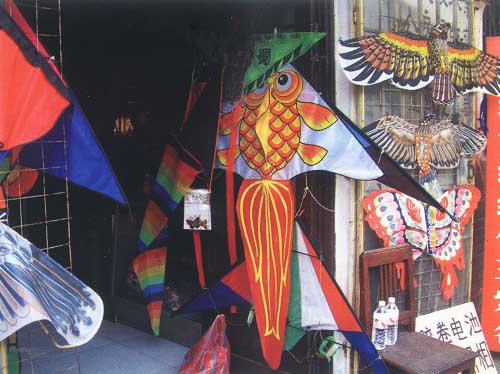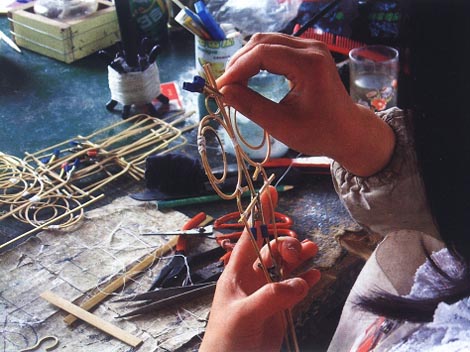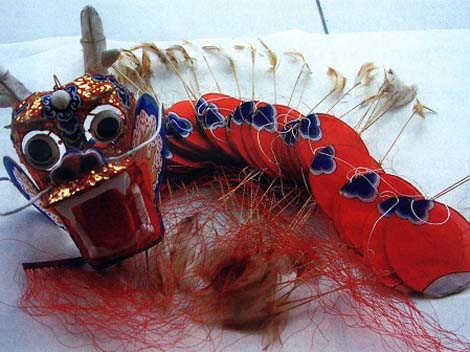Weifang of Shandong Province is a city famous for its traditional handicrafts and also for its kites. In 1984, the First International Kite Festival was held here. In 1988, Weifang was elected "the Capital of Kites of the World." Then, in 1989, the headquarters of the International Federation of Kites was set up here. Every April, Weifang holds an international kite festival.

A Butterfly, a kite of Weifang, Shandong
Walking into this kite capital of the world, you will be lost in a colorful world of kites: everywhere in the city, over the skies of the streets, all kinds of kites in a variety of colors, forms and different schools of art are flying, contending for beauty.
Many folk arts can be found in Weifang City. Its New Year paintings, paper-cuts, silver inlaid articles and cloth toys all claim several hundred years of history. However, the city's most famous art is still its kites.

Shops selling kites, such as this one, are found everywhere in Weifang
Weifang is one of the birthplaces of China's kites and also one of the four main kite producers in the country. Weifang's kites have a history of more than 2,000 years, commanding the same fame as those of Beijing and Tianjin. During the Ming and Qing dynasties, the kites of Weifang reached their peak. Around the festival of Pure Brightness, when the Chinese mourn their ancestors, every family flies the kites they have made and are most proud of.Zheng banqiao (1693-1765)_, a poet and artist of the Qing Dynasty who had been county magistrate, wrote a poem describing the magnificent scene of the time: "Paper flowers fly over the sky like snow; Charming women play the swing over a circle; Their five-colored skirts sway in the wind, like butterflies fighting each other to usher in the return of spring."
The subjects of the kites of Weifang are varied, their designs are exaggerated and distorted, and the appearance of the kites has the style of a New Year painting. It seems that all kinds of kites of the world can be found here. Some of the shapes are impossible to imagine until you see them in person, such as stereoscopic towers, buildings, bells, flower baskets, fans, palace lanterns, tiles with geometric patterns, the Eight Diagrams and the five stars. They differ in quality. Apart from the traditional materials like silk, satin and paper, there are genuine feathers with which to make eagle-shaped kites. The most interesting is a form of kites called "Sending Meal," which relies on wind power to send articles to the sky along the line of the kite and when the article reaches the top it will bump against the horizontal stick attached to the kite beforehand and the vanes of the article will fold up and automatically slide down along the line of the kite.
The animals, including eagles, doves, tigers, goldfish, frogs, butterflies, dragonflies and legendary figures, including Sun Wukong, the Monkey King, Chang'e, the moon fairy, the God of Longevity, Chinese characters like fu (fortune), lu (rank), shou (longevity) and xi (happiness), and even various kinds of houses and utensils can be the subjects for kites. And they can be flown, whether they are huge or the size of a palm.

Making the framework of a kite
The paintings on the kites are rich and colorful. There are Red-crowned Cranes with Children, Peacocks Flaunting Their Tails, Propitious Bats and Phoenix Spreading Their Wings, all of which symbolize auspiciousness and good luck, and fairy tales and legends like Chang'e Ascending to the Moon, The Eight Immortals, The heavenly Fairies Scattering Blossoms and Magu, the fairy who presents birthday gifts to the Lady Queen Mother. The kite makers of Weifang have also introduced the traditional Chinese painting skills to kites. Because Yangjiabu was the birthplace of woodblock New Year paintings of Weifang, the style of kite paintings of Weifang is similar to that of local woodblock New Year paintings. Therefore, the kites of Yangjiabu are also called woodblock New Year painting kites. One of the processes in making this kind of kites is to cut the figures of human beings or animals from the newly printed woodblock New Year paintings and to paste them on the framework. Great importance is attached to painting the kites. Many of the kite makers in Weifang are masters of traditional Chinese paintings and they can merge the skills of painting with the kite's overall appearance. The birds on the kites are so exquisite that each of their feathers is detailed; the veins of insect wings are visible; and the children, old folks and beauties are all meticulously rendered. Thus, the kites of Weifang are of extremely great ornamental value and often collected as interior decorations.

A Dragon, a kite of Weifang, Shandong
The kites of Weifang can be divided into hard-wing, soft-wing and cluster. In hard-wing, two bamboo strips form the framework of the wings and the middle part is arranged into a fixed rectangular frame, and then pasted with paper or silk to make it easy to fly high. In soft-wing, the frame of the lower part is not used but the rest of the hard-wing kite is. This makes the kite lighter and more flexible. The subjects of the soft-wing kites are mostly flying swallows, butterflies and dragonflies. The cluster is made by stringing several kites together with one or more strings. A representative is a centipede with a dragon head. A centipede-with-dragonhead kite of several dozen feet long flying into the blue sky presents a magnificent sight.
It takes several steps to make a kite, including drafting, making the framework and pasting it with paper or silk. A test flight is also considered one of the processes. This is because a kite must not only be beautiful, but, more important, capable of being flown, Tying and binding are the two major steps in making a kite. In tying a kite, one bakes fine bamboo strips slowly on an alcohol stove and bends them into various shapes and then ties them up into different kite molds.
Wandering around Weifang feels like a dream with so many kites in a blaze of colors flying all over the sky. The restaurants hang kites over their windows as decorations; small firms and shops hang kites as their shop signs. Weifang is truly a city of kites. The kites became famous because of the city, and the city becomes beautiful because of its kites.





